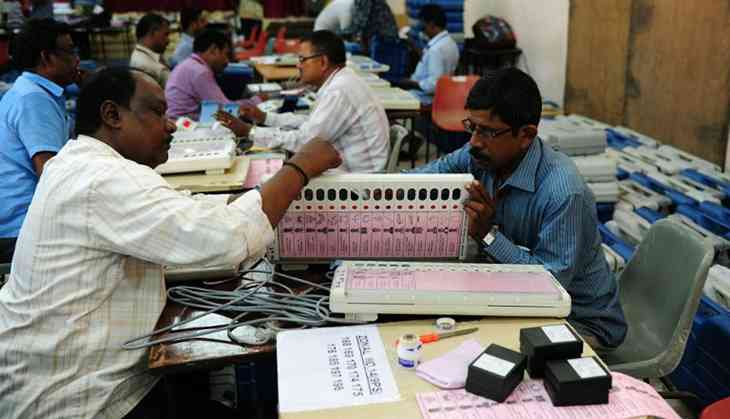
As India’s polling process gets more and more cumbersome because of the ever expanding size of the electorate, the election process is getting lengthier and more complex.
But the counting of votes that once used to take several days for completion now is done in less than 12 hours and with greater precision in calculation. This has been made possible by the introduction of an electronic device into the polling process by the Election Commission of India (ECI). Earlier, voting was a time-consuming job as we had to stamp against the name and symbol of our candidate ourselves while today it is just a game of a button.
In those times, we could come out of a polling booth with a sigh of relief that our vote has gone to the candidate we wanted, but now can we say the same with surety?
The common man has no idea what happens inside the machine once we press the button. The appliance, the Electronic Voting Machine (EVM), has survived legal challenges, since the time it came to be introduced in a by-election in 1982.
But political parties that end up on the losing side tend to cast doubts on the reliability of these machines. This has been a common story of every election.
However, the concerns are too important to be ignored and require deeper investigation and analysis in the larger interest of preserving democracy.
Can the EVMs be hacked?
This is a question that has been tested several times and has even reached the Supreme Court of India in a Public Interest Litigation (PIL) filed by BJP leader Subramaniam Swamy.
The concerns assume significance in the light of the fact that the machine is accessed by people not belonging to the Election Commission (EC) at different stages of its life cycle: the manufacturing companies; the foreign companies that supply micro-controllers and the private players involved in the maintenance of the EVMs.
In a paper ‘Security Analysis of India’s Electronic Voting Machines’, eight computer scientists have argued that Indian EVMs are vulnerable to serious attacks that can alter the election results.
These computer scientists include a PhD holder from Princeton University and managing director of a research and development firm in Hyderabad.
In another paper published by International Electrical & Electronics Engineering Journal by Professors of Computer Science, it has been argued that EVMs aren’t safe and trustworthy, with Indian EVMs being the least safe and trustworthy. These findings cast serious concerns that need to be studied further and acknowledged.
International experiences
In 2009, Germany's Supreme Court ruled that e-voting was unconstitutional stating that an ordinary citizen is not privy to the processes in the casting of the actual vote including recording and tallying.
It ruled, “It did not matter that electronic voting machines were efficient. Their use was a violation of the fundamental right to information as the voter was unable to see clearly to whom he was casting his vote and how it was being counted. It was a constitutional principle in German law that the transparency of elections was more important than the efficiency of conducting elections.”
Netherlands banned the voting machines on the grounds of lack of transparency and risk of eavesdropping.
Ireland initiated e-voting scheme in 2006. The scheme involved several innovations such as touch-screen voting and was launched with amidst much fanfare.
However, three years later it scrapped the whole initiative because of lack of people’s faith in the machines.
There is a growing demand of paper ballots in the USA too with California banning EVMs use altogether.
Conclusion
The EVMs must have a provision of the paper trail in them – a proof that can be verified at the time of casting the vote. This is called the Voter Verified Paper-Audit Trail (VVPAT) system. This would address most of the objections raised against the EVMs. In the event of a dispute about the result, the paper ballots can be hand-counted.
The Supreme Court of India in the judgment of PIL filed by Dr Swamy ruled, “The paper trail is an indispensable requirement of free and fair elections. The confidence of the voters in the EVMs can be achieved only with the introduction of the 'paper trail'. EVMs with VVPAT system ensure the accuracy of the voting system. With an intent to have the fullest transparency in the system and to restore the confidence of the voters, it is necessary to set up EVMs with VVPAT system because a vote is nothing but an act of expression which has immense importance in a democratic system.”
However, allowing for a paper trail will mean a huge jump in costs and in the average time taken for casting the vote.
This becomes all the more important in the light of the claims by Shrikant Shirsat, an independent candidate who secured 0 votes in Bombay Municipal Polls. He along with his family claims that he voted for himself.
In Punjab, Election Commission had VVPAT system in 32 Vidhan Sabhas. This system is like the Decision Review System (DRS) used in cricket. It is used only when a party feels aggrieved by the decision of the umpire and is confident enough to challenge it.
It is time the EC orders recounting of the paper trails and restores faith in Indian democracy and its own credibility. This system, after all, was instituted for a moment like this only.
Saurabh Bhardwaj’s act of tampering a replica of EVM that isn’t connected to any other device by means of Wi-Fi, Bluetooth or wire has raised serious questions about the trustworthiness of EVMs.
Scepticism is the currency of democracy. Let’s be sceptical.
(The author is a member of Aam Aadmi Party and currently works on education policy research and design with Ministry of Education, Government of Delhi. Views expressed are personal.)
First published: 20 May 2017, 17:11 IST

